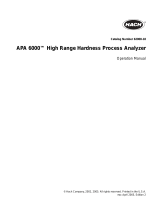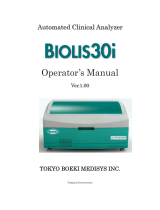Page is loading ...

Testing Procedure:
1. Add whole blood to the ll line on the centrifuge cup or serum / plasma to ll line
on serum cuvette.
2. Press the [1] key on the Main Menu to initiate a measurement.
• The table cover will open and the STAND-BY screen is displayed.
3. Press the [6] key to bring up and scroll through the species menu.
4. Press [ENTER] to select the desired species.
• Unit will go back to the STANDBY screen
5. Press the [1] key for ID.
6. Enter the test number (if desired) otherwise press [ENTER].
7. ID option will appear - enter patient number or name, press [ENTER].
• The [+/.] key is the space key and can be used to move the cursor to the next number/
letter key.
8. When using serum/plasma, place the serum cup in the serum holder.
• Skip to step 12.
9. Remove centrifuge cover by pulling backwards and upwards.
10. Place the centrifuge cup with whole blood in position on the indented area of the silver
tabs.
11. Install centrifuge cover.
12. Place the pipette tip in the Tip Hole.
13. Place the reagent strips on the reagent table.
• Reagent pads on single strips should be facing up and aligned towards the rear of the
instrument.
• Reagent pads on multi strip should be facing up and aligned towards left side of the
instrument.
14. Press [START] key to begin measurement.
• When the measurement is completed, remove used strips/centrifuge cup/cuvette and
discard them.
• Instrument is ready to run the next sample.
How to run a sample:
E02
(T): Trouble with the table Cover.
(M): Trouble with the maintenance Cover.
• The measurement table was open during measurement or
warm up
• The maintenance cover was opened during measurement
or warm-up
• The table cover is not properly closed (foreign material may
be preventing closing)
• The measurement was started without closing the
maintenance cover
• Close the table cover correctly (remove obstructions)
• Set the maintenance cover in the correct position
E05
(1~9): Channels with abnormalities
• A check shows the optical system status has changed since
the last calibration
• The white and black plate or Optical window (window plate)
is dirty
• Clean the white and black plate or Optical window (window
plate) - see sections 4-2-1 and 4-3-2 in the owner’s manual
E11
(7~9): Single Type (M): Multi type
Channel with no Reagent strip in either case. Display is made only in
calibration. Usually nothing is displayed during measurement.
• Reagent strip is not set
• The bar code was not correctly read due to displacement or
bending of the Reagent strip
• The Reagent strip is not set in the channel necessary for
calibration
• Set Reagent strips correctly
• When calibrating, swipe all necessary numbers on card
E13
(7~9): Single Type (M): Multi type
Channel with a different Reagent strip in either case.
• The bar code was not correctly read due to displacement or
bending
• The wrong reagent strips was set for calibration
• Calibration was started for an item before it was completed
for another item
• Set the Reagent strip correctly
• Return to the main menu because changing the item
mid-calibration is not allowed when doing the calibration
E14
(7~9): Single Type (M): Multi type
Channel has used Reagent strip in either case.
• Reagent strip is already used
• The Reagent strip pad is colored because of an old Reagent
strip of inappropriate preservation
• The Reagent pad is dirty
• The bar code was not correctly read due to displacement of
bending of the Reagent strip
• Use a new Reagent strip
• Set the Reagent strip correctly
E17
• A sample vessel is misplaced
• There is no sample or an insufcient amount of sample
• A centrifuge tube was used in calibration by calibrator kit
• Re-set the sample correctly
• Conrm the amount of the sample
• Be sure to use cuvettes in calibration by calibration kit
E32
• Reagent strip has expired.
• Clock is not correctly adjusted
• Clock is not correct because the power was not connected
for a long time
• When using a Reagent strip from new lot, the corresponding
magnetic card to the lot was not inserted
• Use a new Reagent strip
• Adjust the clock
• Insert a new magnetic card
E38
• The tip waste receptacle is not correctly set • Set the tip waste receptacle correctly
E40
(1~9): Channels with abnormalities
• Failed to draw the sample and drop it to the Reagent
correctly due to lack of sample amount or absorbing brin
• Sample adhered around the dropping hole
• Check the sample amount and remove brin if necessary
• Wipe off the sample adhered around the dropping hole
• Measure with a different tip
T25
(1-5, 7-9): Channels with abnormalities
• White plate or black plate is dirty • Clean the white plate or black plate. (Note: the case in
which trouble is detected when the power is turned on, it
is necessary to turn on the power again after maintenance
since measurement cannot be started)
T03
(1-5, 7-9): Channels with abnormalities
• The pressure does not increase since the rubber plate is
dirty or deformed
• The tube or pipe is clogged
• The tube connecting the nozzle with the pump is
disconnected
• The tube connecting the pump with the pressure detecting
sensor is disconnected
• Clean the rubber plate
• Check the tube
• If the same trouble occurs, contact your distributor (Note:
in cases where the abnormality is detected when the power
switch is turned on, it is necessary to turn on the power
again after maintenance because the measurement could
not be started)
E02 Cover Open
OK (ENTER)
E05 Optical Error
(9 6 2) OK (ENTER)
E11 No Strips
( M) OK (ENTER)
E13 Wrong Strips
( 87 ) OK (ENTER)
E14 Used Strips
(9 ) OK (ENTER)
E17 No Sample
(CNTRFG) OK (ENTER)
E32 Invalid Strips
( 7 M) OK (ENTER)
E38 Tip Case Not Set
OK (ENTER)
E40 Sample Drop
( 7 4 1) OK (ENTER)
T25 Barcode Sensor
(8 5 3) OK (ENTER)
T03 Tube Pressure
OK (ENTER)
Troubleshooting
Description and Error Message Conditions and Causes Corrective Action
Centrifuge Cover
Place the Pipette Tip in Holder
Place Test Strip on Reagent Table
ll line
max 500 �L
ll line 250 �L
ll line
min 100 �L
Contact scil animal care toll free at 877.724.5838
Contact scil animal care toll free at 877.724.5838
SPOTCHEM
™
EZ Quick Instruction Guide SPOTCHEM
™
EZ Quick Instruction Guide
scil animal care company • 151 N. Greenleaf St. Gurnee, IL 60031 • P: 877-724-5838 • www.scilvet.com scil animal care company • 151 N. Greenleaf St. Gurnee, IL 60031 • P: 877-724-5838 • www.scilvet.com
Whole Blood – uses centrifuge cup
1.Using a lithium heparinized collection tube (recommended method)
• Aspirate sample into syringe (no anticoagulant)
• Remove needle from syringe
• Dispense sample into lithium heparin collection tube and mix sample
• Transfer sample into centrifuge cup
2. Direct transfer to centrifuge cup
• Aspirate sample into syringe (no anticoagulant)
• Remove needle from syringe
• Dispense sample directly into centrifuge cup
• Re-install orange cap on centrifuge cup
• Mix sample in centrifuge cup; verify sample is completely heparinized
before proceeding (minimum of 2 minutes)
Plasma/Serum – uses cuvette
• Prepare plasma/serum sample
• Transfer sample into cuvette tube
Sample Preparation:
Centrifuge cup Placement
Cuvelte
Centrifuge Cup

1. From the main menu, press the [3] key to Calibrate.
The calibration menu is displayed.
2. Press the [1] key for card calibration.
3. The instrument will prompt to insert a card. Insert card with
stripe into reader and slide to the right.
4. The instrument will prompt to swipe the same stripe again. Insert card with the same stripe
into reader and slide to the right.
5. The instrument will then prompt to swipe another stripe on the card. Insert card with a
different strip into reader and slide to the right.
6. The instrument will then prompt to swipe the same stripe again. Insert card with the same
stripe into reader and slide to the right. Repeat this process with remaining two numbered
stripes. The test name and lot number is displayed.
7. Calibration is successful! Press the [STOP] key twice.
Contact scil animal care toll free at 877.724.5838
Contact scil animal care toll free at 877.724.5838
SPOTCHEM
™
EZ Quick Instruction Guide
SPOTCHEM
™
EZ Quick Instruction Guide
scil animal care company • 151 N. Greenleaf St. Gurnee, IL 60031 • P: 877-724-5838 • www.scilvet.com
Cleaning the Reagent Table - Daily Maintenance:
Card Calibration Procedure:
1.) From Main Menu
1. Measure 2. Submenu
3. Calibrate (1/1)
Ready
Please turn off
Turn OFF Power
1. Results 2. PARAM
3. Maintenance (1/2)
2.) Brush off dust with
cleaning brush.
3.) Clean Reagent
table.
4.) Empty waste case
and disinfect with
alcohol and wash
with water.
5.) Disinfect centrifuge
cover with alcohol
and wash with
water.
Wipe with cotton swab
moistened with distilled water.
Cleaning the Black and White Plates & Cleaning the Rubber Plates -
Monthly Maintenance:
1.) From Main Menu
1. Measure 2. Submenu
3. Calibrate (1/1)
Ready
Please turn off
Turn OFF Power
1. Results 2. PARAM
3. Maintenance (1/2)
2.) Clean Back and White
plates:
3.) Remove top cover. 4.) Clean the rubber
plate.
5.) End cleaning. Turn
power off.
1. Measure 2. Submenu
3. Calibrate (1/1)
Warming up.....
Turn ON the power to start
warm-up. The Reagent Table
and Centrifuge and Multi
Rack slide back and the
Table cover closes. When
[MAIN MENU] appears, turn
OFF the power or perform
testing.
Wipe with a soft, lint free
cloth moistened with distilled
water. Then wipe again with
a dry, lint free cloth.
Insert cotton swab
moistened with distilled
water. Wipe rubber plate
with a cotton swab.
Clean nozzle and Optical Window - as directed by scil technical assistance
1.) Remove top cover and
side cover.
2.) Remove nozzle tube.
3.) Clean nozzle by inserting
cleaning wire through the
nozzle. Wipe debris
coming out of the tip of
nozzle with cotton swab.
4.) Reassemble nozzle
assembly tubing.
5.) Remove tip waste case.
7.) Using a ashlight, clean all 9
optical windows with a dry
cotton swab.
6.) Lay device on right side with
feet. Remove rubber cover.
Calibrate once per box of test strips. The SPOTCHEM™ EZ will not perform an uncalibrated test.
Important Prevention Recommendations:
1. When cleaning the optical windows - customer should use a ashlight to determine whether
the windows are streak free.
Warranty risk if optical windows are dirty / streaky / cloudy
2. Always empty the tip waste case when instructed by the instrument or prior to performing any
maintenance. Emptying the tip waste case routinely reduces the chance of tips falling into the
unit and jamming the centrifuge unit.
Warranty risk if tips are found inside the instrument
3. The centrifuge rotor has a hole that locks into position to prevent it from spinning freely. This
hole should ALWAYS be at the 12 o’clock position. If it is not at the 12 o’clock position the
instrument will give either a T27 or T28 error message. The customer should be shown how
they can easily rectify this situation by manually moving the centrifuge rotor into the 12 o’clock
position. scil recommends the use of the centrifuge cover at all times.
Swipe Calibration Card
Correct, at the 12 o’clock position Incorrect Incorrect
scil animal care company • 151 N. Greenleaf St. Gurnee, IL 60031 • P: 877-724-5838 • www.scilvet.com
/



